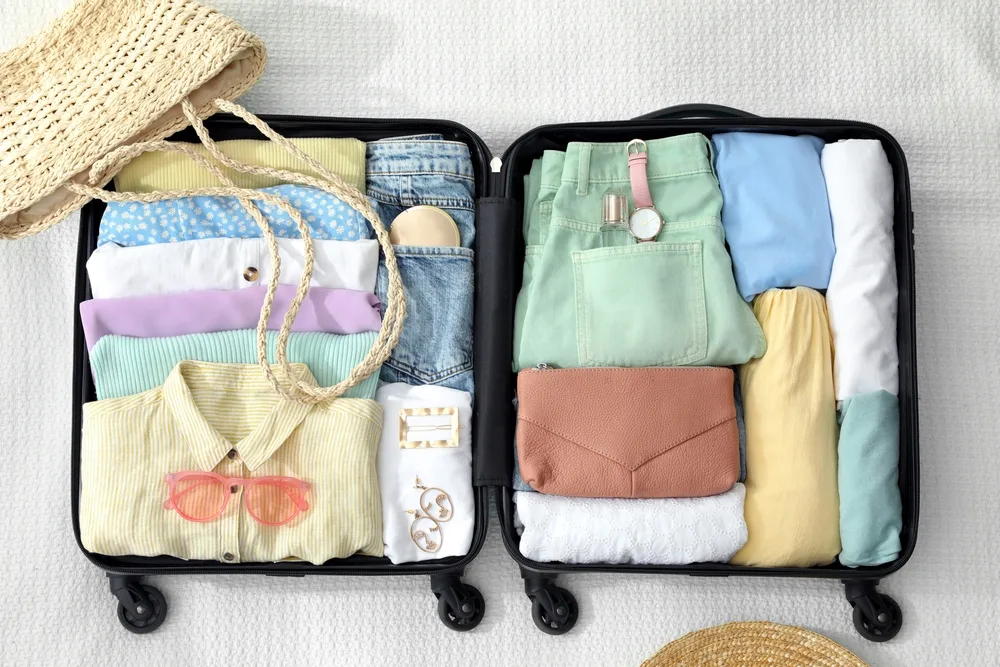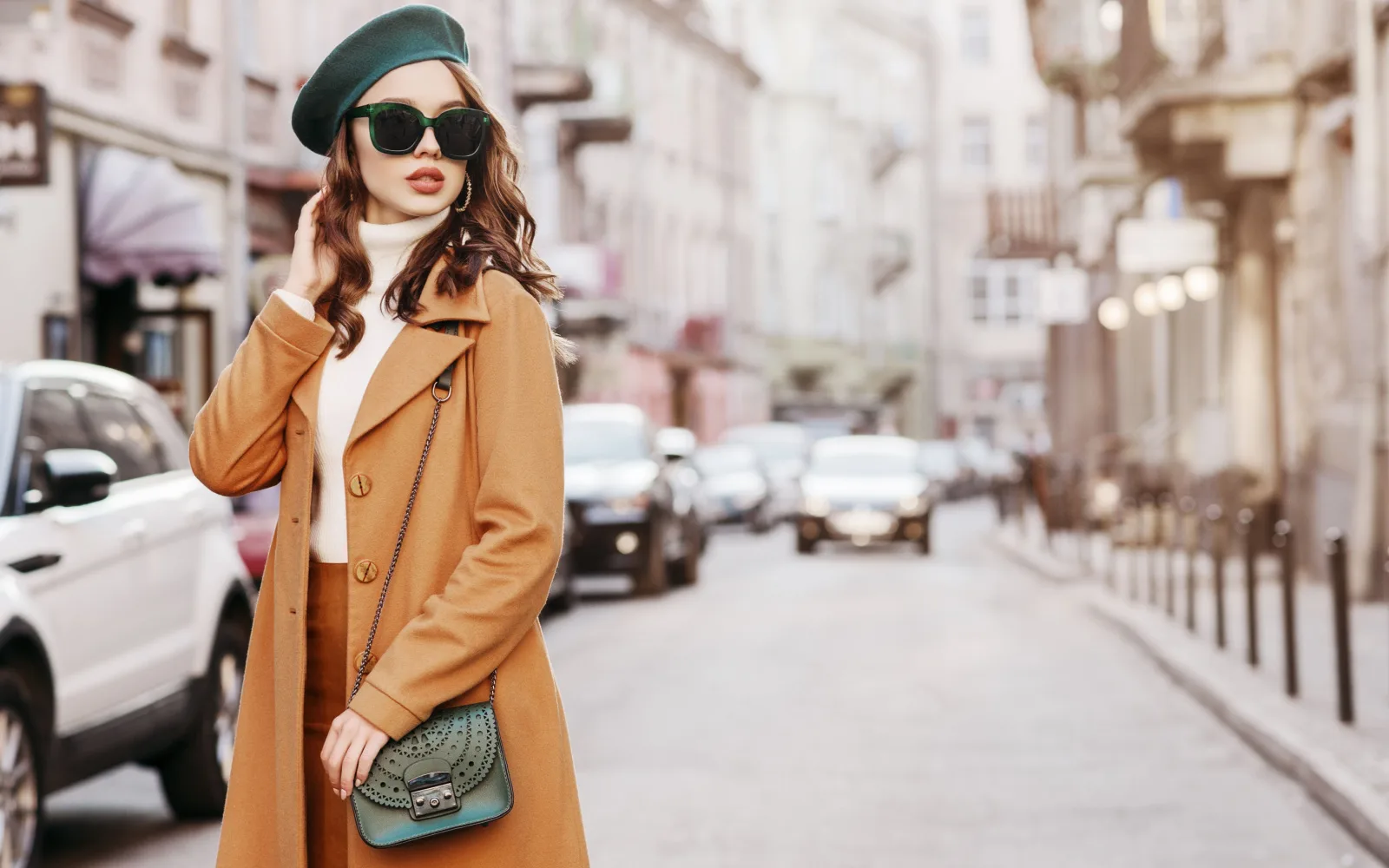If you’re heading to Europe, I have two questions:
- Can I come with you?
- Have you decided what you’ll wear?
Feel free to get back to me any time on the former. As for the latter, knowing what you’ll bring in your suitcase is an important consideration before setting off on your international travels.
Of course, some of your clothing choices will depend on when you visit and where you go, but there are some general rules to follow.
In this post, we’ll address the basic clothing items to bring to Europe, how to pack smart, specific rules for garbing up on the Continent, and some common FAQs.
Basic Guidelines for What to Wear in Europe

Halay Alex/Shutterstock
It is your right to wear whatever you like in Europe. However, some specific guidelines will help you decide what to pack.
Dress Up a Little
While we Americanos might put on jeans and sweaters for nicer occasions and wear our yoga pants to the grocery store, that’s not really done in Europe. Accordingly, you should plan to class up your wardrobe slightly when planning your vacation across the pond.
It’s not uncommon for Europeans to put on nice pants and blouses for the grocery store, and they certainly don’t show up to dinner wearing Lululemon. Actually, athleisure in general isn’t a thing, and that ban holds beyond the dinner table.
Unless you’re actively sweating, forego your stretchy pants in favor of pants, shorts, or dresses when you want to be comfortable. As a bonus, this also makes for better pictures.
While jeans are absolutely acceptable as a fashion item, they’re not necessarily the best choice for travel abroad. They’re hard to wash by hand, they dry slowly, and light washes show stains easily.
Mix Comfort and Style
You want to be comfortable while traveling. Whether you’re walking 17 miles through Parma in search of the best cheese, flying in from the other side of the world, or seeing Europe by train, your clothes better accommodate you – not the other way around.
Rather than digging through your wardrobe and getting frustrated about all the Levis and Under Armor, I recommend just buying yourself a few travel outfits.
Opt for joggers that are as soft as PJs but look like slacks, blazers that fit like drapey shawls, and tuck-in tees made of washable, pill-resistant fabric.
PrAna (our editor Andrew loves the Zion pants) and Pretty Garden are both ethical brands that care about their workers and the world, yet sell on Amazon at prices you can afford.
If you want pieces truly made to stand the test of time, consider Everlane. While it’s more expensive, their focus on the highest manufacturing standards along with timeless styles means their pieces last decades.
Once you get a few main pieces, you can mix your regular comfortable/casual wardrobe in.
Avoid Fussy Clothing Items
Anything that needs careful storage and pressing (slacks and sport coats), doesn’t go on easily (tight jeans), or isn’t comfortable (leather catsuits) should stay at home.
Build a Capsule Wardrobe

New Africa/Shutterstock
I like to fit all my clothes into a carry-on, even when I’m flying overseas. This is much easier if you create a capsule wardrobe.
If you haven’t heard me bang on about this before, here’s the gist: a capsule wardrobe is a collection of clothing pieces that all look well with one another. So each top looks good with each bottom, both look good with the coat and shoes, and it all coordinates well with jewelry and day bags.
The basic items for a travel wardrobe include:
- Tops: Try to pack two to three underlayers and two to three overlayers (shirts or sweaters).
- Bottoms: Two to three bottoms should be enough, spread between pants, shorts, and skirts. If you like dresses, you can either sub this out for a bottom and top to save space, or add it in as an extra piece if space allows.
- Outerwear: Bring a coat warm enough for the coldest temperature you might face, or you could end up buying some very expensive gear abroad. If you’re traveling in colder climes, remember a hat, gloves, scarf, long underwear, and wool socks.
- Loungewear: Even if you’re not going to wear it to the grocery store, you’ll still want cozy hangout gear. Bring a pair of PJs to keep your comfy traveling clothes nice.
- Underthings: Socks, undies, bras, and other underthings are exempt from capsule rules. Pack them as you normally would based on how much laundry access you’ll have.
If you need specialty clothing items, such as thigh-high waders, make sure they match your earrings. (Kidding. Any specialty gear lies outside the capsule wardrobe and should get its own place on your packing list.)
Stick to the Two-Shoe Rule
Even in elegant, sophisticated Europe, two pairs of shoes is fine. In fact, the Europeans are all about doing more with less, so you’ll fit right in. If you’re on a beach trip, then a pair of nice flats for walking and dining out plus a pair of sandals will do.
If you’re in the Alps, you’ll want a pair of rugged hiking or snow boots along with your nice shoes to wear for dinners at the lodge … and so on.
Just make sure all shoes have support. That way, if your walking shoes give you a blister, you can don your sandals for a day without falling arches – a surefire end to any good vacay.
Avoid Ballcaps and Visors
These aren’t really “done” in Europe, so they make you stick out in a crowd. On a personal-fashion level, you might not care – and more power to you.
On a looking-for-foreign-suckers level, this is exactly the type of thing pickpockets scope out, so bring a more formal hat if you need sun protection. May I recommend the ever-classy fedora?
More Specific Rules About Dressing in Europe

Circlephoto/Shutterstock
Some dress codes would never occur to you, but they exist all the same. For instance, you can’t wear sandals while driving in Spain (safety).
Nor can you don high heels to explore Grecian ruins (preservation and also, I feel compelled to add, safety), or wear your swimsuit into town in some parts of Croatia, the Maldives, or Turkey.
Things to Consider
Here are a few more things to consider about how to dress in Europe:
- Islamophobia is on the rise: While there isn’t yet widespread reason to believe that Muslim travelers are in danger in Europe, Islamophobia is unfortunately increasing. Turkey and the EU have been at loggerheads, while French schools have banned traditional dress for Muslim girls. France, Austria, and Denmark are among the most Islamophobic countries, so just be careful where you go if you’re wearing full traditional garb.
- Europeans take dinner more seriously than Americans: In Europe, dinner is an event, and it is treated with care even in the home. Don’t show up to a restaurant or someone’s house wearing shorts and a tee shirt, PJs, or athletic wear. In hostels, though, this is more acceptable.
- Be aware of dress codes in Turkey: Part of Islamic Turkey is located in Europe, where clothing rules are much more relaxed. If you visit Eastern and Southern parts of the country on the Asian continent, however, you’ll want to dress more conservatively. Women should cover their heads, arms, and ankles, and men should avoid shorts. (Note that this is always the case in mosques, even in relatively liberal places such as Istanbul.)
- Leave your jewelry at home: Wear plain wedding rings and costume jewelry if you must, but make sure it doesn’t simulate gemstones. This just makes you a target.
Frequently Asked Questions

Victoria Chudinova/Shutterstock
Here are some frequently asked questions about dressing in Europe:
What constitutes a casual outfit in Europe?
If you’re dressing to dip down to the hotel lobby, have breakfast nearby, pop into the grocery store, climb on a long-haul bus, or do something else casual, what should you wear?
Think of this outfit like one you’d wear to happy hour at a sports bar. Make sure it’s loose, comfy, and nice but not overly fussy. Would you want your friends to see you in it when you’re all out together? Then it’s fine to wear buying cheese in Europe.
Can I wear casual tees?
Ideally, you should leave your graphic tees, brand slogans, and logos behind. These are all Very American things to wear. You don’t want to advertise your foreign status wherever possible – again, this just makes you a target for pickpockets and petty thieves.
What about bags?
Beware of cutpurses. Yes, I wanted to use that word because I’m on a medieval fiction kick right now, but they do still exist. Keep careful watch of your purse or backpack, because thieves are very good at relieving you of them in crowds without you noticing.
It’s better to wear small backpacks in front when in large groups. You can also wear money pouches, crossbody bags in front, or fanny packs.
What else might I need?
If you plan to tour any Islamic attractions, bring respectful clothing. That means pieces that cover your shoulders, knees, and elbows. For women, it also means headscarves and potentially pants that cover the ankles. Ask your tour guide or hotel concierge if you’re going to a mosque or another holy Muslim site.
Time to Pack That Bag and Go!
All right, that’s enough time spent thinking about what to wear in Europe. You won’t get arrested if you wear a graphic tree in the streets of Amsterdam, after all – and frankly, some of the Dutch youth will likely join you – so decide what to pack and just go!



